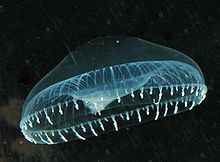Coelenterazina
| Coelenterazina | |
|---|---|
 | |
6-(4-hidroxifenil)-2-[(4-hidroxifenil)metil]-8-(fenilmetil)-7H-imidazo[3,2-a]pirazin-3-ona | |
Outros nomes Coelenterazina, luciferina de Renilla | |
| Identificadores | |
| Número CAS | 55779-48-1 |
| PubChem | 2830 |
| ChemSpider | 2728 |
| ChEBI | CHEBI:2311 |
| Imaxes 3D Jmol | Image 1 |
| |
| |
| Propiedades | |
| Fórmula molecular | C26H21N3O3 |
| Masa molecular | 423,463 |
| Aspecto | cristais laranxa-amarelos |
| Punto de fusión | 175-178 °C |
Se non se indica outra cousa, os datos están tomados en condicións estándar de 25 °C e 100 kPa. | |


A coelenterazina, ou celenteracina[Cómpre referencia], (tamén chamada luciferina de Renilla) é unha molécula do tipo das luciferinas que emite luz, que se encontra en moitos organismos acuáticos de sete filos distintos.[1] É o substrato de moitos encimas luciferases e fotoproteínas como a luciferase Rluc de Renilla reniformis, a luciferase Gluc de Gaussia, a aequorina, e a obelina.
Historia
[editar | editar a fonte]A coelenterazina foi illada e caractrerizada simultaneamente por dous grupos que estudaban os cnidarios bioluminescentes Renilla reniformis e Aequorea victoria, respectivamente.[2][3] Ambos os grupos descubriron independentemente que se utilizaba o mesmo composto neses dous sistemas luminescentes. O nome da molécula procede de Coelenterata (celenterados), o antigo nome dos Cnidaria. Contén un derivado do grupo químico nitroxenado pirazina. Igualmente, os dous principais metabolitos (coelenteramida e coelenteramina) foron nomeados polos grupos químicos que levan.
Distribución
[editar | editar a fonte]A coelenterazina está amplamente distribuída nos organismos mariños, como son:
- radiolarios
- ctenóforos
- cnidarios como Aequorea victoria, Obelia geniculata e Renilla reniformis
- luras como Watasenia scintillans e Vampyroteuthis infernalis
- camaróns como Systellaspis debilis e Oplophorus gracilirostris
- copépodos como Pleuromamma xiphias e Gaussia princeps
- quetognatos[4]
- peixes como algúns Neoscopelidae e Myctophidae
- equinodermos como Amphiura filiformis
O composto foi tamén illado de organismos que non son luminescentes, como o arenque do Atlántico e varias especies de camaróns como Pandalus borealis e Pandalus platyuros.
Propiedades
[editar | editar a fonte]A coelenterazina pode ser cristalizada formando cristais amarelo-laranxas. A molécula absorbe luz no espectro ultravioleta e no visible, cun pico de absorción a 435 nm en metanol, que lle dá á molécula unha cor amarela. A molécula oxídase espontaneamente en condicións aeróbicas ou nalgúns solventes orgánicos como a dimetilformamida e o dimetilsulfóxido (DMSO), e é almacenada normalmente en metanol ou en gas inerte.
Notas
[editar | editar a fonte]- ↑ Shimomura, O. (2006). World Scientific Publishing, ed. Bioluminescence: Chemical Principles and Methods. ISBN 978-981-256-801-4.
- ↑ Hori K, Charbonneau H, Hart RC, and Cormier MJ (1977). "Structure of native Renilla reinformis luciferin". Proceedings of the National Academy of Sciences 74 (10): 4285–4287. PMC 431924. PMID 16592444. doi:10.1073/pnas.74.10.4285.
- ↑ Shimomura O, Johnson FH (1975). "Chemical nature of bioluminescence systems in coelenterates". Proceedings of the National Academy of Sciences 72 (4): 1546–1549. PMC 432574. PMID 236561. doi:10.1073/pnas.72.4.1546.
- ↑ Haddock SHD, Case JF (1994). "A bioluminescent chaetognath" (PDF). Nature 367 (6460): 225–226. doi:10.1038/367225a0. Arquivado dende o orixinal (PDF) o 16 de maio de 2008. Consultado o 24 de xuño de 2012.
Véxase tamén
[editar | editar a fonte]Outros artigos
[editar | editar a fonte]Ligazóns externas
[editar | editar a fonte]- Bioluminescencia cos principais tipos de luciferina
Text is available under the CC BY-SA 4.0 license; additional terms may apply.
Images, videos and audio are available under their respective licenses.
